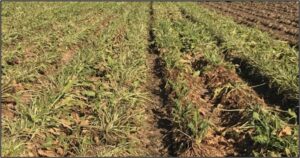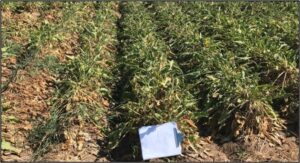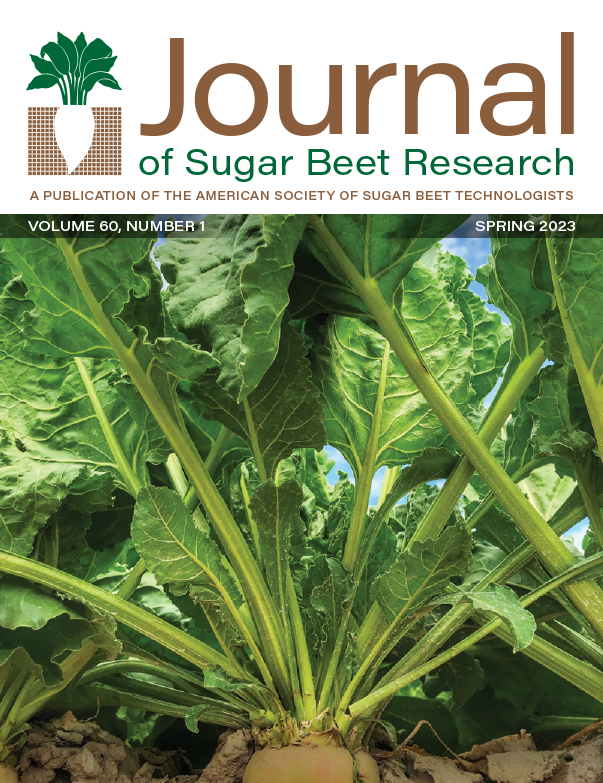Sugar beet is planted in the Imperial Valley during September and October each fall and harvested during the April – July timeframe. During the last half of June and all of July, daily high temperatures in the Imperial Valley often exceed 110 degrees F. This extreme heat, in combination with anaerobic conditions following furrow irrigation applications, can create an environment that favors late root rot development. Late root rot is a complex of two or more pathogens that can rapidly deteriorate a sugar beet root. Pythium aphanidermatum and Phytophthora drechsleri are two primary soil-borne fungal-like pathogens contributing to late root rot losses in fields (UC IPM, 2009). Fields with compromised roots due to rhizomania or nematode infestation are more susceptible to late root rot development. Late root rot complex lowers the sugar content and purity of the beets, which causes issues with factory processing. When late root rot develops in a field, growers have a crew manually remove the rotted beets out of the row prior to harvest. This is a significant harvest cost for these fields. If the root rot development becomes too severe, the entire field can be rejected for delivery. Variety tolerance is one tool to reduce the development of late root rot on fields during the July harvest period. Varying levels of variety tolerance to late root rot complex are shown in Photos 1 and 2, taken at the Imperial Valley Official Variety Trials.
Research Objective
- Evaluate varieties for yield potential and late root rot tolerance in the Imperial Valley of California.
Methodology
Four similar trials were conducted as a randomized complete block with eight replications. Two trials were conducted in the 2020-2021 growing season and two in the 2021-2022 growing season. These trials were the Imperial Valley Late Harvest Official Variety Trials. The variety entries in each season’s trials were not the same. However, six varieties were common to all four trials. The experimental units were two 30” rows wide by 21 feet long. No inoculation occurred at any of the trial sites, disease development was from natural infestation. Disease pressure was uniform across both Location 2 trial sites based on harvest root rot counts. In the 2020-2021 trials, there were sixteen varieties entered into the trials. In the 2021-2022 growing season, fifteen varieties were entered into the trials. The trials were planted at a 1.25” seed spacing and thinned to a 5” spacing at the four to six-leaf stage. Following thinning, initial stand counts were taken on a whole plot basis. The cooperating grower applied crop protection products to match the production practices on the field that surrounded the trial. Table 1 contains the planting date and harvest date for each trial location.

Photo 1. Differences in late root rot tolerance between the variety on the left compared to the variety on the right from 2021-2022 Location 2.

Photo 2. Differences in late root rot tolerance between the variety on the left compared to the variety on the right from 2020-2021 Location 2.
At harvest time, prior to defoliation, all beets within each plot that had visual foliar symptoms of late root rot were counted. The harvest root rot count was divided by the initial stand count taken after thinning to calculate a percent stand loss due to root rot for each plot. Following defoliation, all beets with visual above ground late root rot symptoms were rogued out of the row to exclude them from the harvest yield. Only beets without visual above ground root rot symptoms were harvested and included in the yield calculations. This is consistent with the roguing practice that growers are expected to do when root rot is present in their field. All plots were harvested with a two-row research harvester. Plot weights were recorded on the harvester, and a sub-sample of the beets was brought to the Spreckels Sugar tare lab for tare, sugar, and purity analysis. Dr. Richard Horsley analyzed the individual trials. A spatial analysis of each trial location was conducted using the MrBeanApp (Butler et al., 2018) (Rodriguez-Alvarez et al., 2018).
Table 1. Important dates for each of the four locations.
| Location | Planting Date | Harvest Date |
| 20-21 Late Harvest Loc. 1 | Oct. 12, 2020 | June 9, 2021 |
| 20-21 Late Harvest Loc. 2 | Oct. 19, 2020 | July 20, 2021 |
| 21-22 Late Harvest Loc. 1 | Oct. 6, 2021 | June 1, 2022 |
| 21-22 Late Harvest Loc. 2 | Oct. 13, 2021 | July 7, 2022 |
Table 2. 2020-2021 Late Harvest Official Variety Trial Results for Locations 1 and 2.
| Variety | Loc. 1 – ESA | Loc. 1 – stand loss % | Loc 2 – ESA | Loc 2 – stand loss % |
| BTS 5460 | 17,525 | 0.0 | 19,172 | 4.3 |
| BTS 5678 | 17,311 | 0.0 | 16,852 | 10.2 |
| BTS 5775 | 17,815 | 0.0 | 17,137 | 12.2 |
| BTS 511N | 18,053 | 0.0 | 8,949 | 51.6 |
| SV 1915 | 18,861 | 0.0 | 13,836 | 35.1 |
| SV 2997 | 18,586 | 0.0 | 14,177 | 33.0 |
| Trial Mean | 17806 | 0.0 | 14,200 | 26.7 |
| CV% | 5 | — | 13 | 36.9 |
| LSD (0.05) | 933 | — | 2,066 | 10.6 |
Table 3. 2021-2022 Late Harvest Official Variety Trial Results for Locations 1 and 2.
| Variety | Loc. 1 – ESA | Loc. 1 – stand loss % | Loc. 2 – ESA | Loc. 2 – stand loss % |
| BTS 5460 | 18,285 | 0.0 | 21,819 | 2.7 |
| BTS 5678 | 18,976 | 0.0 | 18,974 | 9.0 |
| BTS 5775 | 18,288 | 0.0 | 19,140 | 10.1 |
| BTS 511N | 18,042 | 0.0 | 23,015 | 1.5 |
| SV 1915 | 18,629 | 0.0 | 18,678 | 12.4 |
| SV 2997 | 17,903 | 0.0 | 19,090 | 10.1 |
| Trial Mean | 18,278 | 0.0 | 17,695 | 15.3 |
| CV% | 4 | — | 9 | 30.1 |
| LSD (0.05) | 856 | — | 1,743 | 5.1 |
In the non-diseased locations, ESA was more consistent between the varieties than in the diseased locations. In the diseased trial locations, tolerance to late root rot created separation between varieties on ESA. BTS 5460 had low stand loss levels at both diseased locations and the highest or second-highest ESA of the varieties evaluated. BTS 511N’s performance was inconsistent between the two diseased trials. SV 1915 and SV2997 performed well in the non-diseased locations, but the ESA for these two varieties was reduced in the trials with root rot present. BTS 5678 and BTS 5775 had approximately 10% stand loss at both diseased trials, and the ESA on both these varieties was below the top variety.
Results
In both the 2020-2021 and 2021-2022 growing seasons, one set of the trials was harvested in early June, and the second trial set was harvested in July. The two trials harvested in June had no late root rot symptoms in either season and would be considered disease free. The two July harvested trials had late root rot present at harvest time. The 2020-2021 Location 2 trial had the highest level of percent stand loss due to late root rot of the four trial locations. Tables 2 and 3 contain the extractable sugar lbs. per acre (ESA) and the percent stand loss due to root rot for each of the four trial locations. The tables contain data on six varieties that were common to all four trial locations.
Conclusions
Late root rot complex is a significant issue for sugar beet production in the Imperial Valley of California. Variety choice is one of the management practices that can reduce late root rot potential. The choice of the variety planted for fields intended to be harvested during July can significantly reduce the level of late root rot present and maintain the extractable sugar lbs. per acre. Official Variety Trials are an excellent way to screen varieties for late root rot tolerance and can be a valuable resource to growers for variety placement decisions for the late harvest season.
References
University of California Integrated Pest Management. (2009) Sugar Beet Phytophthora and Pythium Root Rots. http://ipm.ucanr.edu/PMG/r735100711.html (accessed 6 October 2022).
Butler, D.G., B.R. Cullis, A.R. Gilmour, B.J. Gogel, and R. Thompson. (2018) ASREML-R Reference Manual. Release 4.0. Technical Report, Queensland Department of Primary Industries, Australia.
Rodriguez-Alvarez, M.X, M.B. Boer, F.A. van Eeuwijk, and P.H.C. Eilers. 2018. Correcting for spatial heterogeneity in plant breeding experiments with P-splines. Spatial Statistics, 23, 52 – 71.

